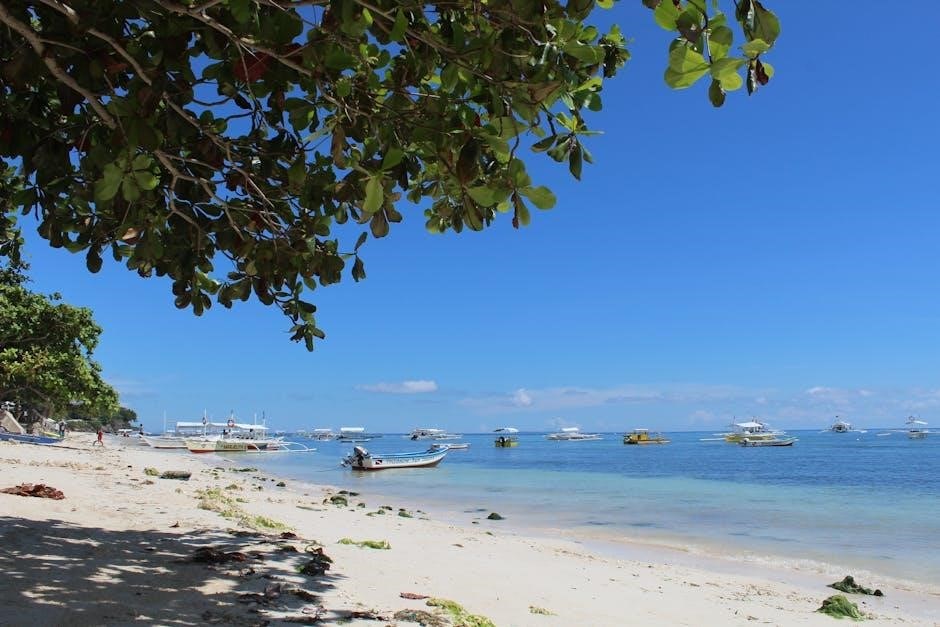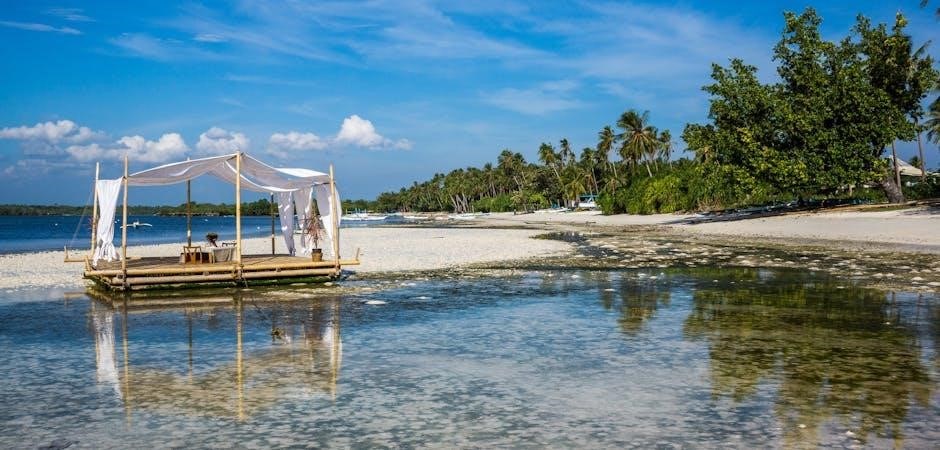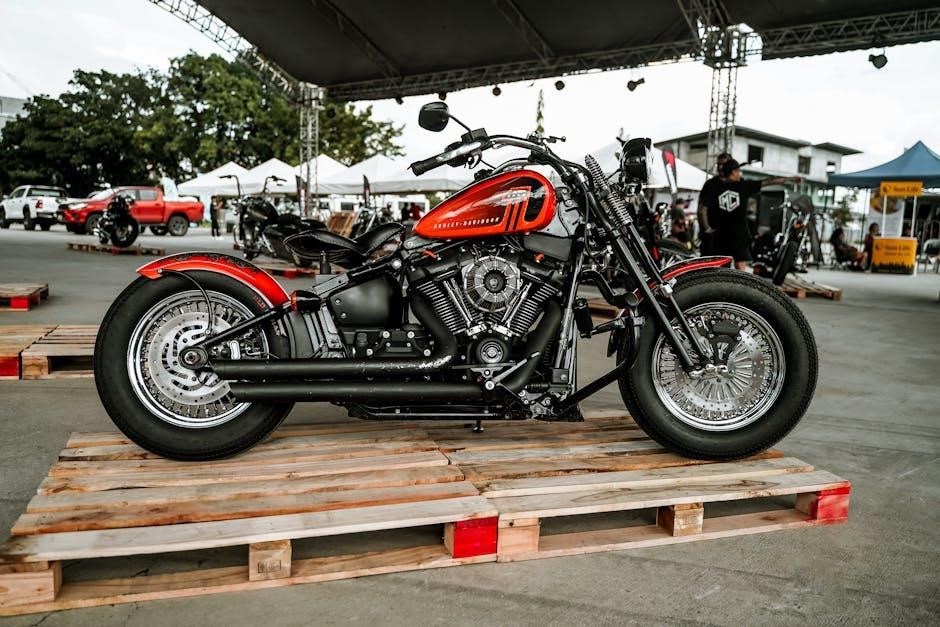Overview of the Philippines
The Philippines is an archipelago of over 7,000 islands, known for its stunning beaches, lush landscapes, and vibrant culture. Located in Southeast Asia, it offers a mix of natural beauty, rich history, and warm hospitality, making it a unique travel destination.
The Philippines is an archipelago of over 7,000 islands located in Southeast Asia, offering a vibrant tapestry of cultures, landscapes, and experiences. With its tropical climate and lush natural beauty, the country is a paradise for travelers seeking adventure, relaxation, and cultural immersion. The Philippines has a rich history, shaped by its indigenous roots, Spanish colonial past, and influences from the United States and Japan during World War II. This diverse heritage is reflected in its architecture, festivals, and traditions. The islands are home to stunning beaches, crystal-clear waters, and breathtaking landscapes, from the iconic Chocolate Hills of Bohol to the majestic Mayon Volcano. Manila, the capital, is a bustling metropolis that blends modernity with historical landmarks like Intramuros. The Filipino people are known for their warm hospitality and resilience, making visitors feel at home. Whether exploring vibrant cities, relaxing on tropical beaches, or experiencing the unique local cuisine, the Philippines promises an unforgettable journey.
Best Time to Visit the Philippines
The Philippines, an archipelago in Southeast Asia, has a tropical climate characterized by two main seasons: the dry season and the wet season. The dry season, which runs from December to May, is the best time to visit, offering sunny weather and minimal rainfall. This period is ideal for beach activities, outdoor adventures, and exploring the country’s many islands.
The wet season, from June to November, brings heavy rainfall and occasional typhoons, which can disrupt travel plans. However, the rainforests and waterfalls are at their most lush during this time, making them a unique experience for nature enthusiasts. If planning a trip, it’s wise to book accommodations and tours in advance, especially during peak travel seasons like December to February, when the weather is coolest and most pleasant.
Visitors should also consider regional weather variations, as some areas may experience rain even during the dry season. Checking local forecasts before traveling is recommended to ensure a smooth and enjoyable trip. Overall, the Philippines is a year-round destination, but careful planning based on the season can make a significant difference in your travel experience.

Key Destinations in the Philippines
The Philippines boasts iconic destinations like Boracay, known for its pristine beaches, and Palawan, famous for its stunning lagoons and El Nido’s towering cliffs. Cebu offers a mix of adventure and history, while Bohol’s Chocolate Hills captivate nature lovers. Manila, the capital, blends modernity with colonial heritage, featuring landmarks like Intramuros.
Popular Tourist Spots in the Philippines
The Philippines is home to some of the world’s most breathtaking tourist spots. Boracay, with its iconic White Beach, is a top destination for beach lovers, offering crystal-clear waters and vibrant nightlife. Palawan, often hailed as the world’s best island, features El Nido’s towering limestone cliffs and the stunning Underground River, a UNESCO World Heritage Site. In Bohol, the Chocolate Hills are a natural wonder, while the Tarsier Sanctuary provides a unique encounter with one of the world’s smallest primates.
Cebu is another hotspot, with Magellan’s Cross and the Basilica del Santo Niño attracting history enthusiasts and pilgrims alike. Manila, the capital, boasts historic sites like Intramuros and Fort Santiago, showcasing the country’s rich colonial past. For adventure seekers, the Mayon Volcano in Bicol offers thrilling hikes, while the surfing paradise of Siargao attracts wave riders from around the globe. These destinations, along with the Philippines’ warm hospitality and diverse culture, make it a must-visit for any traveler.
Hidden Gems and Off-the-Beaten-Path Locations
Beyond the popular destinations, the Philippines boasts a wealth of hidden gems waiting to be discovered. Siquijor, often called the “Island of Magic,” offers a mystical experience with its pristine beaches, waterfalls, and enchanting folklore. Another off-the-beaten-path location is the province of Kalinga, known for its traditional tattoo culture and breathtaking mountain landscapes. For adventure seekers, the island of Marinduque, with its unspoiled beaches and limestone caves, is a treasure trove of natural wonders.
Similarly, the island of Romblon, often overshadowed by Boracay, is home to stunning beaches like Talipasak and Cobrador, where visitors can enjoy serene surroundings. The Caramoan Peninsula in Bicol is another lesser-known destination, featuring untouched islands and crystal-clear waters. These hidden gems offer a chance to experience the authentic beauty of the Philippines without the crowds, making them perfect for those seeking unique and unforgettable adventures.
Travel Tips for the Philippines
Plan ahead and research destinations to avoid peak seasons. Pack lightweight clothing and essentials for varying weather conditions. Respect local customs and traditions, especially in rural areas. Stay hydrated and bring reusable water bottles.
Allocate a budget for transportation and activities. Haggling in markets is common, so practice negotiation skills. Stay informed about local events and festivals to enhance your experience. Always carry a valid ID and travel insurance documents.
Getting Around the Philippines
The Philippines offers a variety of transportation options, catering to different budgets and preferences. Domestic flights are the fastest way to travel between major islands, with airlines like Cebu Pacific and Philippine Airlines providing frequent services. For shorter distances, buses and jeepneys are affordable and widely available, connecting towns and cities. Tricycles, a three-wheeled vehicle, are ideal for short trips, while taxis and ride-hailing apps like Grab operate in larger cities.
Ferries are essential for island-hopping, with options ranging from budget-friendly boats to luxury cruises. Renting a car or motorbike provides flexibility for exploring remote areas. Walking is also a great way to discover local neighborhoods, especially in historic cities like Intramuros. For a unique experience, try a kalesa (horse-drawn carriage) or a banca (outrigger boat) for water journeys.
Plan ahead by booking tickets in advance, especially during peak travel seasons. Use GPS navigation apps like Google Maps or Waze to navigate through unfamiliar areas. Always negotiate fares with tricycle and jeepney drivers to avoid overcharging. With so many options, traveling around the Philippines is both convenient and exciting.
Health and Safety Tips for Travelers
When traveling to the Philippines, prioritize health and safety to ensure a smooth and enjoyable trip. Stay updated on vaccinations, especially for hepatitis A, typhoid, and rabies, as recommended by health authorities. Avoid drinking tap water and opt for bottled or filtered water to prevent waterborne illnesses. Always carry sunscreen, a hat, and sunglasses to protect against the strong tropical sun.
Be mindful of your belongings, especially in crowded areas, to avoid pickpocketing. Use reputable taxi services or ride-hailing apps, and avoid traveling alone at night. Respect local customs and traditions, particularly when visiting churches or attending cultural events.
Stay informed about weather conditions, as the Philippines is prone to typhoons during the rainy season. Carry a first-aid kit and know the location of nearby hospitals. Consider purchasing travel insurance that covers medical emergencies. Lastly, keep emergency contact numbers handy, such as the Philippine National Police hotline (117) and your embassy’s contact information. By taking these precautions, you can enjoy a safe and memorable journey in the Philippines.
Budget Travel Tips in the Philippines
Traveling in the Philippines can be affordable with smart planning and budget-friendly choices. Start by exploring affordable accommodations like hostels, guesthouses, or homestays, which often offer unbeatable prices for travelers on a budget. Consider visiting during the off-peak season when hotel rates drop significantly, typically during the rainy months from June to November.
Eat like a local by trying street food and dining at carinderias, which offer delicious meals at low prices. Public transportation, such as jeepneys and tricycles, is inexpensive and a great way to immerse yourself in the culture. For inter-island travel, opt for budget airlines or ferries, which can be more cost-effective than private transfers.
Plan your itinerary wisely by grouping nearby attractions to minimize transportation costs. Take advantage of free or low-cost activities, such as visiting beaches or exploring local markets. Avoid unnecessary expenses by packing essentials like reusable water bottles and reef-safe sunscreen. Lastly, learn a few basic Filipino phrases, which can go a long way in negotiating prices and building connections with locals. With these tips, you can enjoy the Philippines without breaking the bank.

Cultural Experiences in the Philippines
The Philippines offers a rich cultural tapestry, blending indigenous, Spanish, American, and Asian influences. Vibrant festivals, traditional music, and dance showcase the nation’s heritage. Explore historic landmarks, savor local cuisine, and engage with warm, hospitable communities to truly experience Filipino culture.
Festivals and Celebrations in the Philippines
The Philippines is renowned for its vibrant festivals, which reflect its rich cultural identity and deep traditions. These celebrations are a fusion of religious, historical, and indigenous influences, offering a unique glimpse into the nation’s soul.
One of the most famous festivals is the Sinulog in Cebu, a grand celebration honoring Santo Niño, featuring dazzling street dances and elaborate costumes. Another highlight is the Ati-Atihan in Kalibo, Aklan, which commemorates the arrival of Malay datus with rhythmic drumbeats and tribal performances.
The Pahiyas Festival in Lucban, Quezon, is a colorful spectacle where houses are adorned with vibrant rice grains and natural materials. The MassKara Festival in Bacolod, meanwhile, is a celebration of resilience, characterized by smiling masks and lively street parties.

These festivals are more than just events; they are a showcase of Filipino creativity, faith, and hospitality. They provide unforgettable experiences for travelers, offering a chance to immerse in the country’s dynamic culture and warm spirit.
Local Cuisine and Food Culture
Filipino cuisine is a vibrant fusion of flavors, blending Spanish, Chinese, Malay, and American influences. It is characterized by its bold tastes, aromatic spices, and creative use of local ingredients. Staples include rice, adobo, sinigang, and lechon, each with regional twists.
Popular dishes like chicken inasal (grilled chicken) and sisig (minced pork dish) showcase the country’s love for grilled and savory flavors. Street food is equally thrilling, with options like balut (fertilized duck egg) and kwek-kwek (quail eggs coated in orange batter) offering unique experiences.
Desserts are equally delightful, featuring treats like halo-halo (a colorful mix of shaved ice, fruits, and sweetened beans) and bibingka (rice cake with coconut and egg). The Philippines also boasts a rich tradition of kakanin (rice-based snacks), such as biko and suman.
Food plays a central role in Filipino culture, often served during family gatherings and celebrations. The concept of “merienda” (afternoon snack) reflects the nation’s love for sharing meals throughout the day. This diverse and flavorful food culture makes the Philippines a paradise for food enthusiasts.
Historical and Cultural Landmarks
The Philippines is home to a rich tapestry of historical and cultural landmarks that reflect its diverse heritage. From ancient ruins to Spanish colonial architecture, these sites offer a glimpse into the nation’s complex past.
- Intramuros in Manila is a historic walled city that showcases the country’s Spanish colonial history, with landmarks like Fort Santiago and San Agustin Church.
- The Baroque Churches of the Philippines, a UNESCO World Heritage Site, include iconic structures like Paoay Church in Ilocos Norte and Miag-ao Church in Iloilo.
- Magellan’s Cross in Cebu marks the arrival of Christianity in the Philippines, while the nearby Basilica del Santo Niño houses one of the country’s most revered religious artifacts.
- The Spanish-era towns of Vigan and Taal are well-preserved examples of colonial architecture, offering a step back in time.
- The Chocolate Hills in Bohol, though a natural wonder, are often linked to the island’s cultural identity and folklore.

These landmarks, along with museums like the National Museum Complex in Manila, highlight the Philippines’ vibrant history and cultural diversity, making them essential stops for any traveler seeking to understand the nation’s identity.
